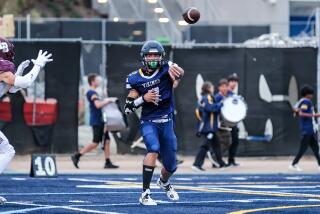Farm System : Lower-Level Teams, Vital to Varsity, Have Been Struggling
- Share via
It’s another perfect day for a high school football game in Orange County.
The sun shines brightly as the kicker gets things under way with a long boot downfield. Players and coaches tense for the coming action. Parents, many with video cameras clutched tightly, and students in T-shirts and shorts surround the field.
The scene is noteworthy for what’s missing: bright lights, marching bands, cheerleaders with microphones, boosters hawking programs or raffle tickets, coaches with headsets, cable TV cameras and fans jammed into a crowded stadium.
Welcome to the world of lower-level high school football, a world only a few parents and close friends take the time to see.
If you’re lucky, you can find a nice cool spot for your beach chair just beneath a shade tree. If not, well, it’s not that hot and dusty standing on that running track.
Yet for all it’s charming innocence, freshman, sophomore or junior varsity games might well be the most important a high school plays.
Consider:
--Future varsity players are on display.
--Lower-level teams serve as a classroom where coaches instruct younger players at a slower rate, ensuring that they are well-schooled by their junior or senior seasons.
--There are no official numbers available, but spokespersons for the National Federation of State High School Athletic Assns., the California Interscholastic Federation and the Southern Section say the vast majority of football players compete on lower-level teams.
--The physical differences between a freshman and a senior can lead to serious injury, officials say. Hence, lower-level teams provide a safe haven for players under 15.
And yet for all the emphasis placed on lower-level football teams, coaches, administrators and, indeed, players and their parents, are waging a bitter fight to keep programs alive in the face of mounting economic hardships.
School districts have to trim their budgets somewhere, and one of the places they look is lower-level programs.
“We only have so much money, and we have to make decisions between putting 45 kids in a classroom and funding lower-level sports,” said Greg Bice, an assistant superintendent in the Fullerton Joint Union High School District.
“We have to make cuts that are furthest from the classroom. But then you can ask, what’s the definition of a classroom? One of the greatest assets of a comprehensive high school is finding a home base for our kids to find success and really feel good about themselves.”
To that end, some schools have restored discontinued programs or those in jeopardy of being axed by raising money on their own. Some raise funds through weekly bingo games. Others have imposed transportation fees of more than $100 per student.
“It’s almost to the point where we’re self-funded now,” said Rick Curtis, Irvine High athletic director. “It’s either that or cut the sports.”
But as coaches and administrators juggle their books to stay in the black, they say they’re facing a new difficulty. Declining enrollment in some areas has meant coaches have had to combine teams.
“This is the first year at Edison that we haven’t been able to field a second freshman team or a JV team,” said Dave White, Edison’s varsity football coach. “The numbers are down. It’s tough.”
In the past, Edison has averaged 130 players in its program. This season, the Chargers are down to 100, according to White.
A casual atmosphere is nice, but most varsity coaches like to see winning results from their lower-level teams. If the freshmen are routing opponents, it follows that they’ll do the same when they reach the varsity.
Indeed, the seeds of most successful varsity programs are sown on the lower levels.
“We feel like we’ve had so much success at Edison (four section championships since 1970) because we’ve been able to play two games at the freshman level,” White said. “Every kid out of the 50 to 60 freshman (in the program) got a chance to play. They didn’t get frustrated and quit. A third of the kids who have started on the varsity have been kids in that freshman reserve game.”
It happens everywhere. Two of this season’s most sought-after county recruits--Los Alamitos quarterback Tim Carey and Capistrano Valley tight end Blake Spence--began their high school careers as members of freshman “B” teams. In time, each blossomed into the county’s best at their positions.
Unlike other sports, freshmen football players rarely make an impact on varsity teams. Only a few meet the 15-year-old age requirement mandated by the State CIF, and those who do are simply not ready to perform at a high level.
For example, only one freshman running back in State history--Ventura Buena’s George Keiaho in 1990--has gained 1,000 yards or more for a varsity team, according to Scott Cathcart, a spokesman for the Southern Section.
“Kids mature incredibly from their freshman to their sophomore years,” Cathcart said. “Boys grow into young men. . . . Football is the only sport that has an age limit.”
Woodbridge Coach Rick Gibson spoke for most coaches when he said: “I firmly believe that a 14-year-old should not be on the field with an 18-year-old.”
Coaches say that, next to the varsity, freshmen teams are the most important that a school fields.
“It’s so important to have a good freshman program,” Irvine Coach Terry Henigan said. “One member of our varsity staff works with the freshmen. We try to get to as many freshman and sophomore games as we can.”
And junior varsity teams rank second in importance to freshman teams, according to some coaches. Their games offer a chance for less-talented seniors and up-and-coming sophomores and juniors to play with and against each other.
“There are two reasons for JVs,” Henigan said. “No. 1 is it prepares you for next year. And No. 2 it prepares kids for this year. Down the road they might crack the starting lineup or we might need them because of injuries.”
On a hot Saturday morning in Orange, perhaps 100 fans stood around a field at El Modena High to watch a junior varsity game between the 3-0 Vanguards and the 2-0 Ocean View Seahawks. The 4,000-seat Fred Kelly Stadium, where the varsity plays its games, loomed in the distance.
Many of the spectators held video cameras. One brought along a ladder to capture the game from a better vantage point. There are no bleachers present, and most fans reclined in beach chairs just a few steps from the sideline.
The chain gang consisted of members of the Vanguard varsity who were being disciplined for one reason or another. One brought his fast food breakfast along, but the bag was soon crushed when an Ocean View player was tackled out of bounds.
It was a typical Saturday morning for Larry Hadley, El Modena’s junior varsity coach. He’s been through it all before.
“This is an interesting group,” he said. “We’ve got five or six kids who played three or four years of organized football in area youth programs. Then you have about a dozen kids who just want to play and thought football would be fun. And then there are four or five athletes who are trying to find their niche in different sports. They basically try everything as freshmen and sophomores, then pick one sport.
“You’re fooling yourself as a coach if you say you don’t want to win. But you have to remind yourself that lower-level programs are the learning system for kids who will, hopefully, play varsity some day. Basically, I’m there to teach the fundamentals. I think you do more teaching as a lower-level coach. On the varsity, you’re more involved with strategy.”
For Howard Isom, Ocean View varsity coach, the Seahawks’ junior varsity team is a source of some pride. While the varsity has struggled in recent seasons, the JVs have been winners.
“Our JV program is our hope for the future,” Isom said. “But you have to be careful about success on that level. There’s no pressure, and the won-loss record can be misleading. Those kids aren’t under the lights with fans sitting in the stands watching their every move. They’re learning the game and having fun. The lower-level programs are our developing ground.”
On the field, the game rolled on. El Modena, running only the simplest plays, eventually outlasted an Ocean View team that had outscored its opposition, 90-0, coming into the game.
In the end, the final score was as unremarkable as the action. El Modena won, 21-6.
At game’s end, players, coaches and parents packed up their belongings and headed home. In a matter of minutes, the field was empty.
But they’ll all be back soon enough. After all, these lower-level games are the backbone of each school’s varsity team.
Times staff writer Tom Hamilton contributed to this story.
More to Read
Get our high school sports newsletter
Prep Rally is devoted to the SoCal high school sports experience, bringing you scores, stories and a behind-the-scenes look at what makes prep sports so popular.
You may occasionally receive promotional content from the Los Angeles Times.






